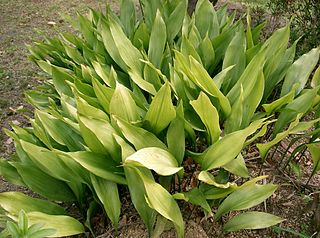
Aspidistra is a genus of flowering plants in the family Asparagaceae, subfamily Nolinoideae, native to eastern and southeastern Asia, particularly China and Vietnam. They grow in shade under trees and shrubs. Their leaves arise more or less directly from ground level, where their flowers also appear. The number of species known has increased considerably from the 1980s onwards, with around 100 accepted as of July 2013. Aspidistra elatior is common worldwide as a foliage house plant that is very tolerant of neglect. It and other species can also be grown in shade outside, where they are generally hardy to −5 °C (23 °F).

Adenophora is a genus of flowering plants in the family Campanulaceae, the bellflowers. Plants of this genus are known commonly as ladybells. Most are native to eastern Asia, with a few in Europe. Many are endemic to either China or Siberia.

Paris is a genus of flowering plants described by Linnaeus in 1753. It is widespread across Europe and Asia, with a center of diversity in China.

Rohdea is a genus of plants native to eastern Asia. It was long thought to contain only a single species, R. japonica, but recent studies have resulted in several other taxa being transferred into the genus.
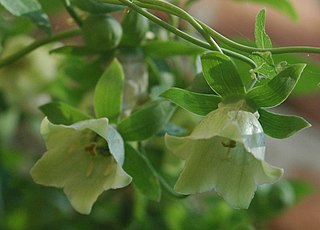
Codonopsis is a genus of flowering plant in the family Campanulaceae. As currently recognized, Codonopsis includes two other groups sometimes separated as distinct genera, i.e. Campanumoea and Leptocodon. The enlarged genus Codonopsis is widespread across eastern, southern, central, and southeastern Asia, including China, Japan, the Russian Far East, Kazakhstan, the Indian Subcontinent, Iran, Indochina, Indonesia, etc.

Aletris, the colicroot, colicweed, crow corn, or unicorn root, is a genus of flowering plants in the Nartheciaceae family, native to North America and to eastern and southeastern Asia, especially China. It was used as a component in Lydia Pinkham's original Vegetable Compound.

Hemipilia is a genus of plants in the family Orchidaceae. It is native to China, the Himalayas and Southeast Asia.
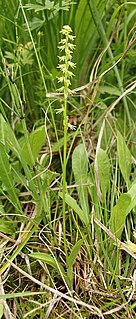
Herminium is a genus of plants in family Orchidaceae, widespread across much of Europe and Asia.

Kobresia is a genus of plants in the sedge family. They are sometimes called bog sedges. These perennial sedges are quite similar to Carex species in appearance. The genus is widespread across much of Europe, Asia and North America, with many species native to the Himalayas.
Tricarpelema is a genus of monocotyledonous flowering plants in the dayflower family consisting of 8 species. The genus is divided into two subgenera, subgenus Tricarpelema, which includes 7 known species found in tropical Asia, and subgenus Keatingia with one species in western Africa. The Asian species are typically found in the forest understory while the single African species has evolved to drier, sunnier conditions and is usually associated with inselbergs.

Gastrochilus obliquus is a species of orchid native to China, the Himalayas and Southeast Asia. Two varieties are recognized:
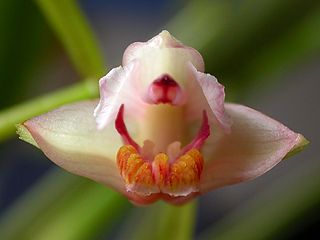
Cryptochilus is a genus of flowering plants from the orchid family, Orchidaceae. Its species are native to China, the Himalayas, and Indochina.
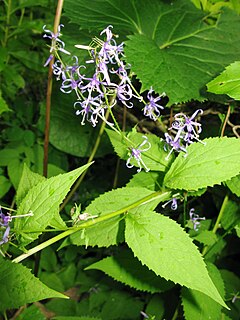
Asyneuma is a genus of flowering plants in the bellflower family, Campanulaceae. They are native to North Africa and Eurasia. Many are endemic to Turkey. Plants of the genus may be known commonly as harebells, but this name can also apply to the entire family. There are up to about 33 species.

Craterocapsa is a genus of plants in the family Campanulaceae. It contains 5 known species, all native to southern Africa.
Echinocodon is a genus of plants in the family Campanulaceae. There is only one known species, Echinocodon lobophyllus, endemic to the Chinese Province of Hubei.
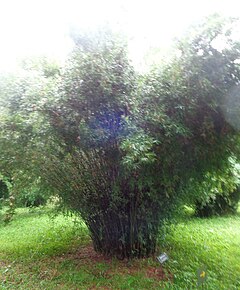
Bambusa multiplex is a species of bamboo native to China, Nepal, Bhutan, Assam, Sri Lanka, Taiwan, and northern Indochina. It is also naturalized in Iraq, Madagascar, Mauritius, Seychelles, the Indian subcontinent, parts of South America, the West Indies, and the southeastern United States.
Microtoena is a genus of flowering plants in the mint family, Lamiaceae, first described in 1889. It is native to eastern and southeastern Asia, primarily China.
- Microtoena albescensC.Y.Wu & S.J.Hsuan - Guizhou
- Microtoena bhutanicaStearn - Bhutan
- Microtoena coreanaH.Lév - Korea
- Microtoena delavayiPrain - Sichuan, Yunnan
- Microtoena esquiroliiH.Lév. - Yunnan, Guizhou, Guangxi
- Microtoena griffithiiPrain - Arunachal Pradesh, Bangladesh
- Microtoena insuavis(Hance) Prain ex Briq. - Thailand, Vietnam, Guangdong, Guizhou, Yunnan
- Microtoena longisepalaC.Y.Wu - Sichuan
- Microtoena maireanaHand.-Mazz. - Yunnan
- Microtoena megacalyxC.Y.Wu - Guizhou, Yunnan
- Microtoena miyiensisC.Y.Wu & H.W.Li - Sichuan
- Microtoena mollisH.Lév. - Guizhou, Yunnan, Guangxi
- Microtoena moupinensis(Franch.) Prain - Tibet, Sichuan
- Microtoena muliensisC.Y.Wu - Sichuan
- Microtoena nepalensisStearn - Nepal
- Microtoena omeiensisC.Y.Wu & S.J.Hsuan - Sichuan
- Microtoena patchoulii(C.B.Clarke ex Hook.f.) C.Y.Wu & S.J.Hsuan - from Yunnan + Nepal south to Java
- Microtoena paucifloraC.Y.Wu - Yunnan
- Microtoena praineanaDiels - Guizhou, Sichuan, Yunnan
- Microtoena robustaHemsl. - Sichuan, Hubei
- Microtoena stenocalyxC.Y.Wu & S.J.Hsuan - Yunnan
- Microtoena urticifoliaHemsl. - Hubei, Hunan
- Microtoena vanchingshanensisC.Y.Wu & S.J.Hsuan - Guizhou
- Microtoena wardiiStearn - Tibet, Bhutan, Arunachal Pradesh

Mosla is a genus of plants in the family Lamiaceae, first described as a genus in 1875. It is native to eastern Asia, the Himalayas, and southeastern Asia.
- Mosla bracteataDoan ex Suddee & A.J.Paton - Vietnam
- Mosla cavalerieiH.Lév.- Vietnam, Guangdong, Guangxi, Guizhou, Hubei, Jiangxi, Sichuan, Yunnan, Zhejiang
- Mosla chinensisMaxim. - Vietnam, Korea, Japan, Anhui, Fujian, Guangdong, Guangxi, Guizhou, Hubei, Hunan, Jiangsu, Jiangxi, Shandong, Sichuan, Taiwan, Zhejiang
- Mosla coreanaH.Lév. - Korea
- Mosla dianthera(Buch.-Ham. ex Roxb.) Maxim. - China, Japan, Korea, Ryukyu Islands, Kuril Islands, Primorye, Caucasus, Himalayas, Myanmar, Vietnam, Philippines, Sumatra
- Mosla exfoliata(C.Y.Wu) C.Y.Wu & H.W.Li - Sichuan
- Mosla hangchouensisMatsuda - Zhejiang
- Mosla japonica(Benth. ex Oliv.) Maxim. - Japan, Korea, Ryukyu Islands
- Mosla longibracteata(C.Y.Wu & S.J.Hsuan) C.Y.Wu & H.W.Li - Guangxi, Zhejiang
- Mosla longispica(C.Y.Wu) C.Y.Wu & H.W.Li - Jiangxi
- Mosla pauciflora(C.Y.Wu) C.Y.Wu & H.W.Li - Guizhou, Hubei, Sichuan
- Mosla punctulataNakai - Korea, Taiwan, Japan, China
- Mosla scabra(Thunb.) C.Y.Wu & H.W.Li - Vietnam, Korea, Japan, Ryukyu Islands, Anhui, Fujian, Gansu, Guangdong, Guangxi, Henan, Hubei, Hunan, Jiangsu, Jiangxi, Liaoning, Shaanxi, Sichuan, Taiwan, Zhejiang
- Mosla soochouensisMatsuda - Anhui, Jiangsu, Jiangxi, Zhejiang
- Mosla tamdaoensisPhuong - Vietnam
Rubiteucris is a genus of plants in the family Lamiaceae, first described in 1929. It is native to southern China, the Himalayas, and Myanmar.
Siphocranion is a genus of plants in the family Lamiaceae, first described in 1929. It is native to China, the Himalayas, and northern Indochina.














